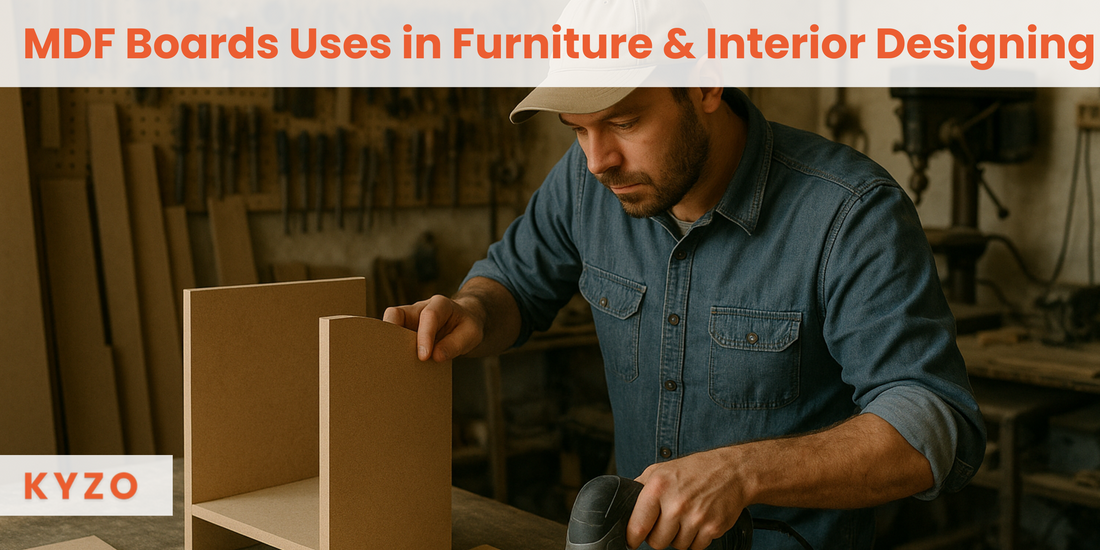
MDF Boards Uses in Furniture & Interior Design
Share
Medium Density Fibreboard (MDF) is now widely used in interior design and furniture manufacture because of its durability, limitless versatility, and aesthetic appeal. It is thereby invariably drawn upon for a number of applications-from homes to commercial settings such as hotels. In this blog, we will delve into various uses of MDF, its advantages, and its suitability for different interior designs.

What is MDF?
MDF- medium-density fiberboard- is an engineered wood product manufactured by heating, applying pressure, and binding together wood fibers with resin and sometimes wax. The result is an MDF panel of high quality: dense, smooth, and uniform with no semblance of wood grain, knots, or other imperfections generally associated with solid wood. The other very important factor is that the expanded avenues for customization permitted in the production process make MDF the most versatile material for furniture and design applications.
You can also explore our Mdf Boards collections here.
Top 8 MDF Board Uses
1. Furniture Manufacturing: A Superior Choice for Home and Hotel Furniture
MDF is quite a popular material as it is stable, strong, and cheap for furniture manufacture. Compared to solid wood, MDF is highly ideal for the construction of a wide variety of furniture as it has higher water and temperature resistance. In the making of cabinets, bookshelves, wardrobes, and even tables, it is really helpful.
An easy application of veneers, laminates, or paints can now be done with MDF very well, providing a flat and smooth surface for unlimited design possibilities that are pleasing to the eye. Whether you're thinking of modern minimalist furniture or even more traditional, ornate designs, MDF is the perfect base material.

MDF has proven to be highly valuable in hotel furniture. It has very high durability along with customizability and no warping, making it a strong competitor among frequently used furniture materials that can withstand changing conditions within hotel environments. It can further accommodate intricate designs, making it optimal for the creation of stylish, high-end furniture that benefits guests.
You can also read about laminate colour combinations for wardrobe designs.
2. Cabinetries: They are So Reliable and Customizable
MDF can be considered a one-word answer to the question of where to apply it for purposes in different rooms of the house, namely; kitchens, bathrooms, or the office: cabinets. It's the darling of materials that makes tough beauties of cabinets. One characteristic that often makes it an ideal material for the manufacture of cabinet doors is that it can achieve a perfectly smooth and even surface, a prerequisite for achieving a uniform and smooth veneer finish.

For this, it is almost a perfect board for high-moisture areas such as kitchens and bathrooms, as it will not bow over time or under the moisture effect. Its surface looks good fused with laminates, which allows it to look at how solid wood or any design is directly achieved.
The versatility of MDF allows it to create cuts, thus making completion possible with an experiment on styles-from raised through flat to custom inset panel designs-with an assurance of strength and durability intact.
To read more about Kitchen Door Designs, click here
3. The Wall Panels and Cladding: Aesthetic Appeal and Practicality
Yet another popular use of MDF is in the form of wall panels and cladding; the uniformity of the surface and its ease of machining make MDF perfect for wall treatments that are not only decorative but also for different public spaces such as hotels and restaurants. Carved or shaped, wall panels can take just about any design, be it classical or contemporary.
In hotel interiors, such MDF wall panels are not only supposed to enhance the visual status of a room but also serve other functions like noise dampening, sleek background for art, and protection from wall damage.

MDF can also be used for a false ceiling or partition, giving a very clean modern appearance while maintaining the integrity of the material even with the passing of years. It prevents damage as a result of moisture and change in temperatures. Thus, the design is intact dealing with humid areas as well as high-traffic areas.
4. Doors And Shutters: Tough And Quiet
MDF is a very popular choice for doors and shutters. Because of its dense nature, MDF doors provide really good sound insulation and are used well in homes and offices. These are unsuitable for warping, making them ideal for doors and shutters that are regularly opened and closed.

MDF doors can be designed to give a perfect luxury, smooth design for hotel entrances. Proper finishing with high-quality veneers or paints makes MDF appear as solid wood with additional strength and durability. Also, because of the high customisability of the MDF, hotel owners are free to design the doors to fit the overall theme and décor of the property.
5. Custom Shaped Parts and Mouldings: Freedom to Create
MDF is easily put into shape, so there is no limitation to the custom shapes and mouldings that can be made. Designers can carve into it, or provide decorative edges and ornamental styles that give their own unique feel to any piece of furniture or décor.
With easy customization, designers can come up with their own designs for hotel furniture like fancy headboards, elaborate wall features, and furnishings reflecting their own design theme or aesthetic. The use of MDF provides that flexibility to these explorations with complex design options, be it intricate crown moulding, baseboards, or furniture legs.
6. Crafts and Decorative Items: Ideal for DIY Projects
MDF isn't just for making furniture; it has a wide array of uses in crafting and small DIY projects. With its smooth and even surface profile, MDF is most suitable for items such as picture frames, decorative trays, sculptures, and many more. In addition, the workability quotient of MDF makes them a good contender in the arts and crafts segment for making personalized or custom-designed items.
For hotels looking at unique decorative items, MDF is a good candidate to shape and finish for specialty pieces such as custom signage, photo frames, and even small decorative sculptures. It provides one of the best options to give hotel interiors a personal touch while keeping the costs low.
You can also have a look and read about Plywood Mandir designs here.
7. The flooring and tabletops: strong and sturdy
Although MDF is generally not recommended for flooring, it is perfectly suitable for creating smooth, durable surfaces for tabletops and workstations. In a commercial hotel setting, an MDF table would endure heavy use while still offering a sleek, modern appearance. Thanks to its smooth surface, MDF is ideal for laminates, which can create attractive, low-maintenance surfaces in restaurants, conference rooms, and lounges.

MDF is also excellent for worktops in offices or kitchens due to its hardy nature and weight-bearing capability, forming a good base for any task.
You can also read about Can wooden flooring be laid over tiles?
8. Sustainability and Environmental Benefits
Amongst the numerous advantages associated with MDF would be its eco-friendliness. This is because MDF happens to be made from fast-growing renewable resources, including agricultural waste, which does not require trees to be cut down. Although most of the MDF these days is manufactured using low-emission adhesives, thus improving its environmental impact.
Greener hotels and designers can opt for eco-responsible material choice by choosing into the resource that is the above-quoted MDFs for their eco-friendly design and enduring use.
Conclusion: The Future of MDF in Interior Design
In general, MDF would be one of the most varied, inexpensive, and durable materials used for different purposes, including furniture manufacture and fine design work. The ability to customize MDF at will and resist moisture, temperature, and pests make it a fitting candidate for residential and commercial homes.
For contemporary homes, boutique hotels, or high-end resorts, MDF offers a myriad of benefits to make creative designs that increase the appeal of any space. Flexibility in design and stability, along with its environmental benefits, ensure that MDF will continue being a choice material for designers and furniture makers for years to come.
FAQs
Q1. What are the main advantages of using MDF over solid wood or plywood?
Ans. MDF is a board made from particles of wood which are bound together with glue. MDF has very high dimensional stability, a perfectly smooth surface ideal for painting, and resistance to warping, unlike solid wood or plywood, which are prone to swell or crack at varying temperatures and humidities.
Q2. Is MDF conducive for high moisture areas such as a kitchen or bathroom?
Ans. Yes, there is an MDF that is moisture-resistant, such as HDFWR, which prevents water damage and is durable even in kitchens and bathrooms-high moisture area.
3. Can an item made of MDF serve the dual purposes of functional and decorative furniture?
Ans. Definitely! With a range of possibilities, MDF could constitute furniture like cabinets for use in dwellings and even as an ornament since there is paint or laminate finish on it; it would appear fantastic.
4. What about RDF's performance in terms of environmental sustainability?
Ans. To be made out of such fibers means that it is about using renewable resources-wood fibers from agricultural waste-and many manufacturers still use so-called "low emission adhesives" in their manufacture.
5. Can MDF redefine design and creativity into fancifully crafted products, or is it easily customized to suit unique or intricate designs?
Ans. Yes, MDF is highly customizable, with the capability of easily cutting, drilling, and forming complex designs, thus being perfect for manufacturing custom furniture and decorative features.



